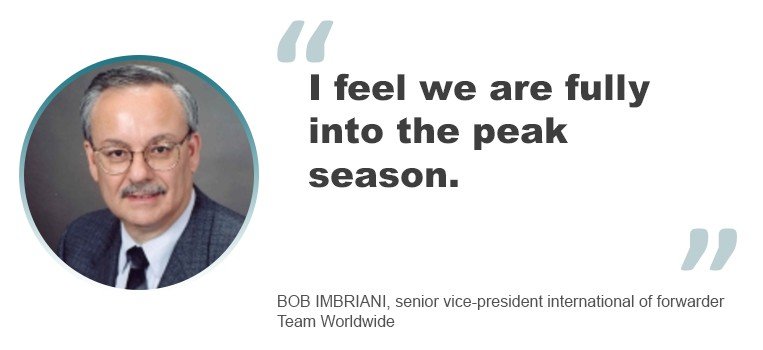The 2021 peak season got off to an early start. Already in July, US West Coast ports and terminal operators were sounding the alarm that the annual surge of imports was under way, as importers were rushing to bring in their cargo early to avoid more serious delays and costs down the road.
“I feel we are fully into the peak season,” confirmed Bob Imbriani, senior vice-president international of forwarder Team Worldwide.
Congestion was bad enough during the normally slack months of the year. The entire US transportation infrastructure has been under severe strain, with delays in nearly all modes of transport except barges. In June the National Retail Federation (NRF) sent a letter to the White House pointing out that the congestion had not only stretched transit times but also caused inventory shortages and added costs for importers.
A survey of its members conducted by the NRF indicates that 97% of retailers were impacted by port and shipping delays and 85% were experiencing inventory shortages because of the ongoing supply chain disruptions.
The ports of Los Angeles and Long Beach have been hit the hardest by the tidal wave of elevated volumes. Los Angeles handled 876,430 TEU in June, up 27% year-on-year, which brought its tally for the fiscal year to more than 10.879 million TEU. In 12 months, the port eclipsed eight monthly records.
The port of Long Beach also kept setting new monthly throughput records and is on course for a 10% increase in its container count for the year over its 8.1 million TEU tally of 2020. Executive director Mario Cordero said that the two ports expect to handle more than 19 million TEU combined this year, up from 17.3 million TEU in 2020.
The ports have made strenuous efforts to bring down the congestion that has plagued them since last year, but their recent successes have run out of steam. Having reduced the number of container vessels at anchorage waiting for a berth from its peak of 40 back in February to the low teens, they suffered a serious reverse in July and August. By August 9, there were 30 ships at anchorage in San Pedro Bay.
One factor behind this was the arrival of a larger number of ships that had been delayed on the other side of the Pacific by the impact of the new Covid outbreak on the port of Yantian.
Other indicators also show deterioration in performance. Maersk warned customers of severe delays, citing container dwell times at the ports as well as strained rail capacity and a shortage of chassis. According to the Pacific Merchant Shipping Association, which represents terminal operators on the West Coast, average container dwell time increased to 11.8 days.
One reason for this is a shortage of warehouse capacity, which is forcing importers to leave containers longer on the docks, despite high demurrage charges, but the delays are also caused by shortages of trucking and rail capacity to move containers out of the ports.
The rail network is severely hampered by large numbers of containers that are choking intermodal hubs in the interior, especially Chicago and Dallas. In mid-July, Union Pacific halted intermodal service from Long Beach, Los Angeles, Oakland and Tacoma to its Global IV terminal near Chicago for seven days in a desperate effort to reduce the congestion at the facility.
A shortage of chassis has been a large factor in the blockage, as it prevented importers and truckers from picking up containers, which piled up at the rail facility, resulting in huge demurrage charges for importers.
The other Class I railroads have suffered from the same problems and have metered intermodal traffic on congested sectors or capped allocations for intermodal marketing companies. According to the Intermodal Association of North America, intermodal volumes were up 20.4% in the second quarter.
For their part, several ocean carriers have metered intermodal bookings through the ports of Los Angeles and Long Beach because of rail congestion.
Already in June there were signs that the capacity problems were affecting the system’s ability to meet demand. The CASS report for June shows a 3% drop in shipping volume from the previous month caused by tight road and intermodal capacity. The American Trucking Association reported a 0.2% decline in truck freight for May, which it attributed not to slackening demand but capacity constraints caused by congestion in the system.
The strain is set to become worse, judging from traffic projections for August. “US import volumes in August are projected to set a new monthly record,” warned Freightos in its weekly market update on August 12. The NRF has predicted an increase of 12.6% in container imports over August 2020.
All of this augurs more disruption and stratospheric pricing through the coming months, leaving shippers and importers wondering when the system – and rates – will finally return to normal. Forwarders and carriers do not expect a change before the end of the year, and some have predicted that the situation would stretch to the 2022 Lunar New Year holiday.
Even then, container rates are not going to return to pre-Covid levels, forwarders have warned. At the port of Long Beach, Cordero expects to see a ‘new normal’ of elevated container volumes.



-x-large.jpg)
